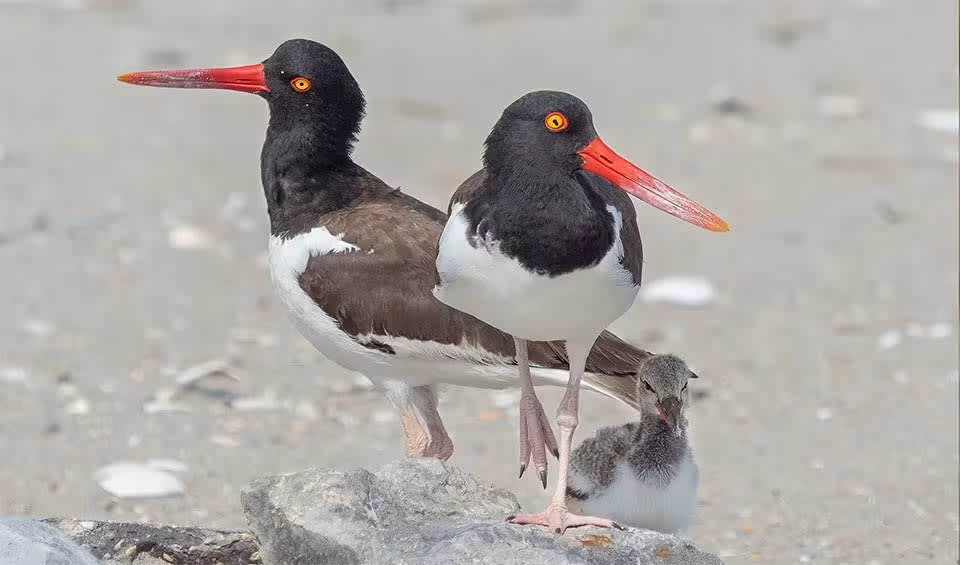With its striking black and white plumage and distinctive red beak, it is undoubtedly one of the most iconic waders found across its range. Renowned for its elegance and adaptability, this species holds a prominent place in coastal ecosystems and is a subject of fascination for birdwatchers and researchers alike.
Despite its name, the Eurasian Oystercatcher is not exclusively confined to oyster-rich habitats. While it does indeed feed on mollusks like oysters, mussels, and cockles, it also has a varied diet that includes worms, crustaceans, and insects. This adaptability allows it to thrive in a range of coastal environments, from saline marshes and sandy beaches to rocky shores and estuaries.
During the breeding season, the Eurasian Oystercatcher exhibits a preference for nesting in saline marshes and on sandy beaches. However, it is not uncommon to find breeding pairs inland, in agricultural areas or near bodies of water such as lakes and rivers. This flexibility in habitat selection reflects the species’ ability to adapt to diverse landscapes and environmental conditions.
In terms of distribution, the Eurasian Oystercatcher is widespread across Western Europe, Central Eurasia, Kamchatka, China, and the western coast of Korea during the breeding season. As the seasons change, it embarks on a southward migration to warmer regions, with some individuals wintering in North Africa and others along the coastlines of southern Europe. Even inland breeders join their coastal counterparts during the winter months, highlighting the species’ propensity for seasonal movements and nomadic behavior.
Distribution
 Afghanistan
Afghanistan Albania
Albania Algeria
Algeria Austria
Austria Azerbaijan
Azerbaijan Bahrain
Bahrain Bangladesh
Bangladesh Belarus
Belarus Belgium
Belgium Bosnia And Herz.
Bosnia And Herz. Bulgaria
Bulgaria Cape Verde
Cape Verde China
China Croatia
Croatia Cyprus
Cyprus Czechia
Czechia Côte D’ivoire
Côte D’ivoire Denmark
Denmark Djibouti
Djibouti Egypt
Egypt Eritrea
Eritrea Estonia
Estonia Ethiopia
Ethiopia Faroe Islands
Faroe Islands Finland
Finland France
France Gambia
Gambia Georgia
Georgia Germany
Germany Ghana
Ghana Gibraltar
Gibraltar Greece
Greece Guinea-Bissau
Guinea-Bissau Guinea
Guinea Hungary
Hungary Iceland
Iceland India
India Iran
Iran Iraq
Iraq Ireland
Ireland Israel
Israel Italy
Italy Japan
Japan Jordan
Jordan Kazakhstan
Kazakhstan Kenya
Kenya Korea
Korea Kuwait
Kuwait Kyrgyzstan
Kyrgyzstan Latvia
Latvia Libya
Libya Lithuania
Lithuania Malta
Malta Mauritania
Mauritania Moldova
Moldova Montenegro
Montenegro Morocco
Morocco Myanmar
Myanmar Netherlands
Netherlands Nigeria
Nigeria North Korea
North Korea North Macedonia
North Macedonia Norway
Norway Oman
Oman Pakistan
Pakistan Poland
Poland Portugal
Portugal Qatar
Qatar Romania
Romania Russia
Russia Saudi Arabia
Saudi Arabia Senegal
Senegal Serbia
Serbia Sierra Leone
Sierra Leone Slovakia
Slovakia Somalia
Somalia Spain
Spain Sri Lanka
Sri Lanka Sudan
Sudan Sweden
Sweden Switzerland
Switzerland Syria
Syria Taiwan
Taiwan Tajikistan
Tajikistan Tanzania
Tanzania Tunisia
Tunisia Turkey
Turkey Turkmenistan
Turkmenistan UAE
UAE Ukraine
Ukraine United Kingdom
United Kingdom Uzbekistan
Uzbekistan Yemen
YemenAnything we've missed?
Help us improve this page by suggesting edits. Glory never dies!
Suggest an editGet to know me
Terrestrial / Aquatic
Altricial / Precocial
Polygamous / Monogamous
Dimorphic (size) / Monomorphic
Active: Diurnal / Nocturnal
Social behavior: Solitary / Pack / Herd
Diet: Carnivore / Herbivore / Omnivore / Piscivorous / Insectivore
Migratory: Yes / No
Domesticated: Yes / No
Dangerous: Yes / No




